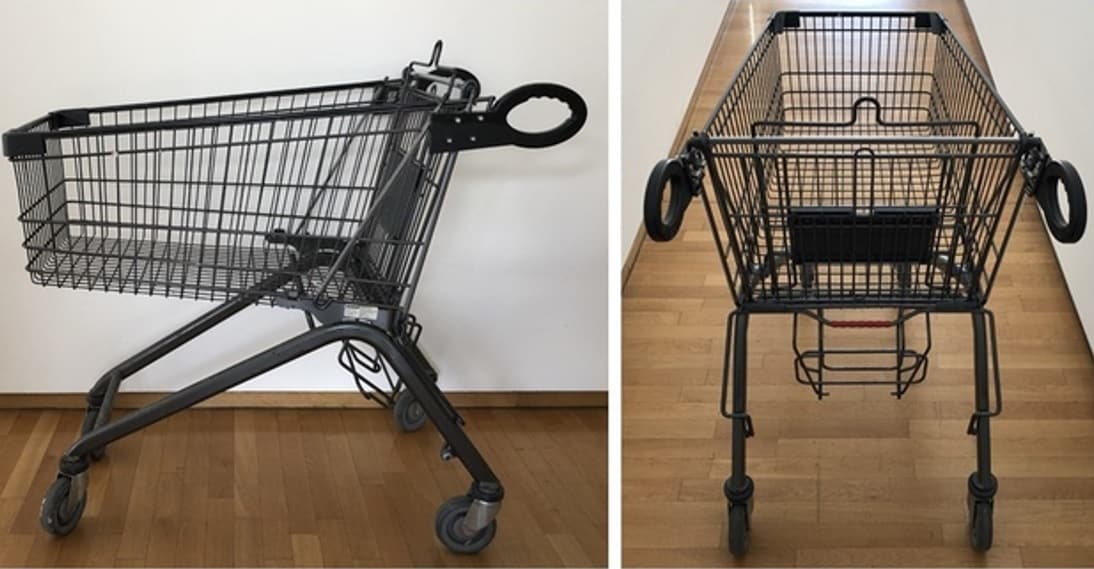
Don’t shop when you’re hungry. Don’t shop without a list. Don’t forget your coupons. And don’t shop with some newfangled shopping cart with strange handles on it.
The first three are standard pieces of advice if you want to save money when grocery shopping. Now a new study says the last piece of advice is one you should heed as well, if you don’t want to overspend at the grocery store.
Hold out your arms and imagine pushing a standard grocery shopping cart with a horizontal bar across the front. Now look at the photo of a prototype shopping cart above, and hold out your arms as you would to push that. Do your arms and wrists feel somewhat more relaxed? Well, beware, because you could end up buying too much and spending too much as a result.
“Getting a Handle on Sales: Shopping Carts Affect Purchasing by Activating Arm Muscles” is a study published in the latest edition of the Journal of Marketing, led by researchers at the UK’s Bayes Business School. While marketers tend to focus on how in-store promotions, store design and atmosphere can stimulate spending, the study noted that “another tool that may influence shopping, but which has received little attention by marketing researchers, is the shopping cart.”
It all has to do with the muscles you use when pushing each type of cart, and what kind of physiological and psychological affect it has on you. You use your triceps when pushing a standard shopping cart, in an arms-extended stance that “is often used to remove or expel objects away from the body,” the researchers write. The parallel-rings design, in contrast, requires the use of your biceps, in a stance that “is often used to bring objects (or foods) toward the body and to secure or ingest them.”
Therefore, pushing a standard shopping cart “facilitates an avoidance-oriented motivation” that can inhibit you from buying, while pushing the newly-designed cart “increases the desire for instant gratification” and “is known to improve attitudes toward objects,” which can cause you to buy more.
The researchers tested out their hypothesis by putting their shopping cart design to the test. They found that their prototype carts “significantly and substantially increased sales across a broad range of categories.” Shoppers using the new cart spent about 30% more than those who used a regular shopping cart, and bought a greater variety of products.
Curiously, those increased purchases tended not to include multiples of the same product. Based upon their research, the authors predicted that their cart would stimulate “variety seeking” behavior, as opposed to stockpiling, so they were unsurprised by the fact that shoppers filled their parallel-ring cart with more individual items and fewer of the same type of items, than they would have by using a regular shopping cart.
“Our results suggest that the shopping carts currently available in nearly every large retail outlet are suboptimal for stimulating sales,” the researchers concluded. They also described meeting with a major supermarket retailer and several cart manufacturers, all of whom “expressed surprise that handle design could stimulate sales.”
Surprise – and, perhaps, interest in introducing these carts to a store near you, in order to get you to spend more? Perhaps.
If so, and you see carts like this in your stores as a result, the researchers say to look on the bright side.
“If shoppers want to minimize their shopping trips,” study coauthor Zachary Estes said in a statement, “they can flex their biceps to pull things into their cart.” In other words, if the new carts cause you to buy more during your shopping trip, you may not need to visit the store quite so often. The carts could also help put you in the right state of mind if you’re just browsing or shopping for fun.
But who goes to the grocery store just to browse for fun? If you’re watching your grocery budget and trying to make smart spending decisions, the researchers say you might want to stick to the tried-and-true. “Standard shopping carts may act as a welcome and unexpected restraint to keep unnecessary purchases out of the cart,” Estes said.
No matter what shopping cart design you find yourself using, to avoid being tempted by unnecessary purchases, “shoppers with a budget should try to maintain an extension posture while shopping,” the study advises.
The typical grocery shopper doesn’t put much thought into how everything from store layout, to lighting, music and scents can affect your mood and how much you buy. But in the case of how your shopping cart can affect your purchasing behavior, it pays to be an informed shopper. “Consumers could benefit from recognizing and regulating the potential impact that shopping devices can have on their consumption,” the report concludes. “We hope that our research and other studies like it can educate consumers about their vulnerabilities in the marketplace.”
Shopping carts have looked pretty much the same since the design was refined and perfected some 80 years ago. If marketers use this research to justify rolling out a new type of shopping cart in order to entice you to buy more – you can’t say now that you haven’t been warned.
Image source: Bayes Business School










